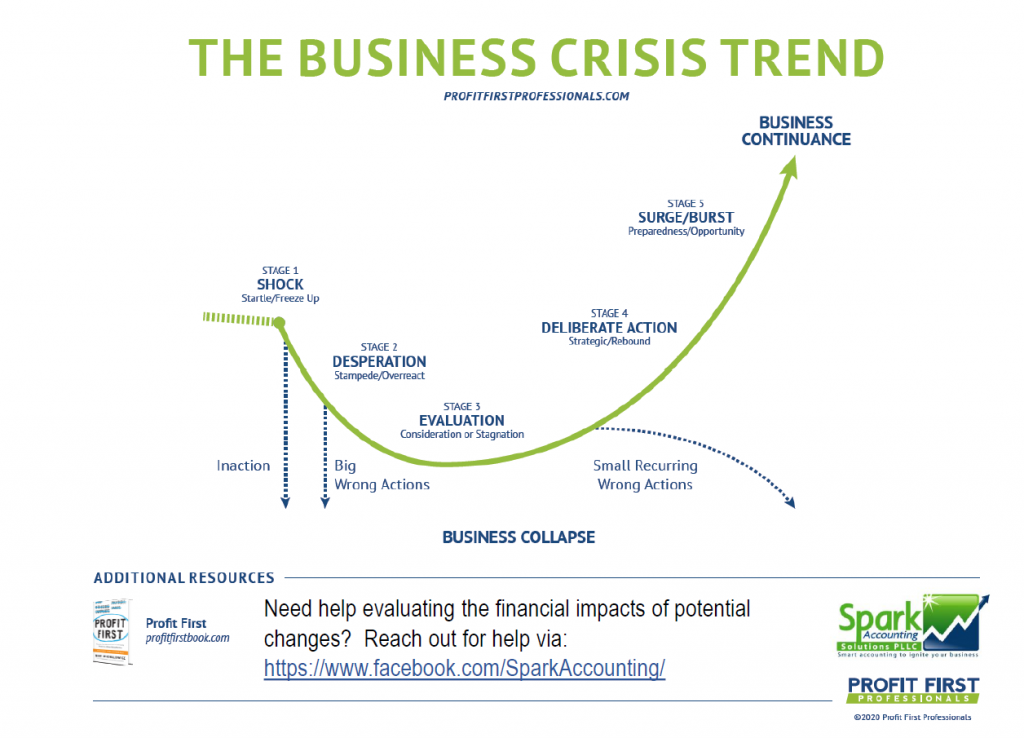You’re probably familiar with the 5 Stages of Grief…. But have you heard about the 5 Stages of Dealing with a Business Crisis?
Mike Michalowicz was nice enough to share this with the Profit First Professionals, so we could also share this with you. This concept has come out as many business owners have been impacted by a global pandemic, but a business crisis can be many things. It can be something as large as a global pandemic, or it can be more localized, to your area or even your industry. For example, what would happen if the product or service that made up 50% of your revenue suddenly became illegal to sell?
These kinds of events can be devastating to small businesses and their owners. Knowing how to process your feelings and move towards deliberate action to move your business forward is critical.
The Five Stages
Stage 1 – SHOCK At this point, business owners are in the “OMG! What Just Happened” state of mind. Typically, they are frozen and unable to think about what they should do next. There are business owners that cannot get past this shock and, without some kind of action, their business will fail. Inaction is not a response to a crisis that will lead to continued survival of your business.
Stage 2 – DESPERATION Once business owners get over shock, many times the next move is one of desperation. Business owners try whatever they can:
- Huge sales to get money in the door, even if they aren’t profitable
- Take out a huge loan and not make changes to the business to reflect the new reality
These are not the correct actions to sustain the business in the long term. If enough BIG wrong actions are taken, the business is going to be unable to continue and will fail.
Stage 3 – EVALUATION After the initial two stages have happened, most business owners can finally get into the process of really looking at the data, what is happening, and figuring out what the business really needs right now. In this phase, it’s very important to stop relying on feelings, and use true data to find out what is really happening.
Businesses that don’t look at the real data, will often continue to make smaller, but recurring, wrong actions that will force them to close, as they have not responded to the new reality.
Stage 4 – DELIBERATE ACTION In this stage, business owners use the data they gathered from the evaluation stage to figure out exactly what the RIGHT actions are that the business needs to take to survive. This is best done one action at a time to move forward, so that you can quickly respond to changes that are happening with your current financial crisis.
In order to avoid a long slow fade out of your business, it’s important to pick those right actions to keep your business moving forward.
Stage 5 – The Burst In this stage, recovery has started. Consumers are buying again. If you’ve made it through the previous 4 stages, some of your competitors have likely dropped off, you’ve made the necessary adjustments to your business, and you are ready to take advantage of this growth opportunity for your business.
How Your Accountant Can Help
Working through these stages can be difficult without a neutral third party to help you in the evaluation stage. Accountants are typically really good with data, and helping you understand what the data is saying. Here are some ways to utilize your accountant:
- Understand your current cash position – given your current expenses, how long will your current cash balance carry you?
- Assist with reviewing your opportunities for decreasing cash outflow – and we recommend having that set of extra eyes help you look at your business AND your personal situation.
- Analyze opportunities for bringing in more funds – are there receivables you can collect? Are there other ways your customers can pay than the current methods you offer?
- Get help developing a cash flow plan – what happens if your current business crisis lasts 3 months? 6 months? 12 months? What will things look like? What changes need to be made?
- What types of debt should you be looking at? Let your accountant help you identify your options and determine an appropriate amount and borrowing period, and refinancing options.
- Plan for taxes – if you were on track to make 5 times more before your business crisis, you probably need to adjust the amount you are setting aside for your estimated tax payments
- Evaluate opportunities for growth as competitors drop off and new opportunities are identified. What kind of financial impact should be projected for those opportunities?
There are many ways your accountant can support you through a business crisis. If you need help, our team at Spark Accounting Solutions is available to assist.
Free Resource
If you’re interested in receiving a PDF handout outlining the 5 Stages of Dealing with a Business Crisis, along with some specific strategies you can take to both protect your business through the crisis AND prepare your business for the upcoming surge, please click this link to sign up for a free download: https://bit.ly/BusinessCrisis.
